Remember Sy Sperling, who wasn’t only the President of Hair Club for Men, the rug company, but also a client? Elizabeth Parrish is reportedly the Sy Sperling of gene therapy, a significantly bolder endeavor.
The CEO of BioViva says she’s volunteered herself as Patient Zero, the first to receive the company’s experimental, regenerative daily injections to reverse aging. Parrish is a completely healthy 44-year-old person, apart from gradually dying like the rest of us. I’m highly skeptical, of course, that such therapies will be successful, widely available and affordable in a handful of years–or at any point in the foreseeable future–though if our species survives long enough, I think they’ll become reality and make our current state of medicine seem as barbaric to future people as surgery sans anesthesia is to us.
In a Reddit AMA, Parrish was unsurprisingly asked many questions about the cosmetic aspect of the research (regrowing hair lost to baldness, looking younger, etc.), but the paramount goal is clearly longer and healthier lives. A few exchanges follow.
_____________________________
Question:
- What criteria did you use in picking patient zero? How old were they? Did they have any medical conditions which would be fixed by age reversal?
- Suppose you’ve proven to have cured aging with this first patient. How soon before I’m cured also?
- How soon will you be confident enough that your treatment is working? At the one year mark? The full 8 years?
- In the talk that you gave in May, you said that it is your wish to distribute this cure for free. How will you and your team accomplish that?
Elizabeth Parrish:
- I am patient zero. I will be 45 in January. I have aging as a disease.
- We are working as hard as we can to bring it to the world as quickly and safely as possible.
- We will will evaluate monthly and within 12 months we will have more data.
- We will work with governments and insurance providers.
Question:
Are you patient zero because it would be unethical to ask someone else to be patient zero? Because it seems to me that the researcher shouldn’t be the patient unless there’s no other option.
Elizabeth Parrish:
It was the only ethical choice. I am happy to step up. I do feel we can use these therapies in compassionate care scenarios now but we will have to work them back into healthier people as we see they work as preventive medicine.
Question:
How do you feel about being patient zero? Are you apprehensive at all?
Elizabeth Parrish:
I am happy to be patient zero. It is for the world, for the sick children and sick old people. My life has been good. I understand the risks but I research how people die and I am happy to say that today I do not know how I will die now. Tomorrow or in the long future I was up for a change.
_____________________________
Question:
Can you control the aging reversal to determine a prefered age?
Elizabeth Parrish:
We cannot control the aging reversal to a specific year today, that will come in the future. It is hypothesized that you will not reverse in physical appearance to less than a young adult. We see this in mice as well.
_____________________________
Question:
I have only read titles about anti-aging therapy and don’t really know what it’s all about. What are the actual expected results in layman terms? Does a 50 year old individual start looking younger, regaining muscle growth potential, higher testosterone levels, etc or does it just influence a subset of factors?
Elizabeth Parrish:
If you don’t look younger we have failed. Aging is one of the most visual diseases on the planet and includes things that we all know like wrinkles and grey hair, but also brain atrophy, muscle wasting and organ damage.
_____________________________
Question:
How did you administer the treatment? Injection? Where? How many?
Elizabeth Parrish:
Doctors do it by injections in various parts of the body.
_____________________________
Question:
What are your thoughts on accessibility to anti-aging therapy and what is BioViva doing to ensure ethical and fair access to it’s tech?
Elizabeth Parrish:
Our goal is to build laboratories that will have the mission of a cGMP product at a reduced cost. Gene therapy technology is much like computing technology. We had to build the super computer which cost $8 million in 1960. Now everyone has technologies that work predictably and at a cost the average person can afford. We need to do the same with these therapies. What you will get in 3-5 years will be vastly more predictable and effective that what we are doing today and at a cost you or your insurance can cover.
_____________________________
Question:
When do you think an ageing treatment will be available to the general public?
Elizabeth Parrish:
If the results are good we hope to have something to the general public, that is cost acceptable, in 3-5 years.•
Tags: Elizabeth Parrish

